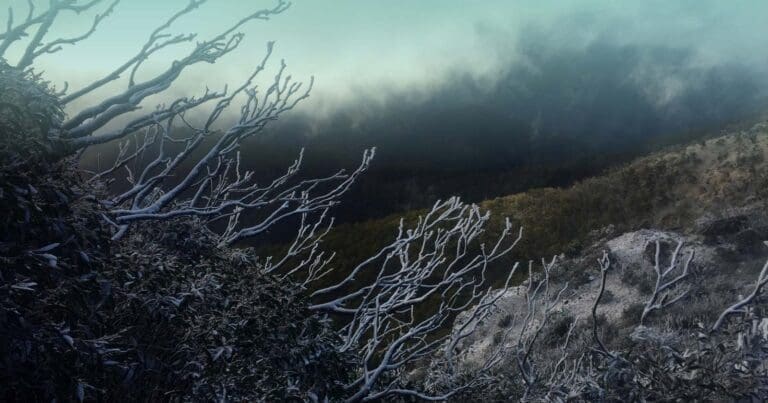Trail Fast Facts
Mt Buller via North Ridge is a 9.2km, grade 5 hike in Alpine National Park, Victoria. This hike typically takes 4.5 hours to complete.
Warning
This is a challenging hike that should not be underestimated. Do not attempt this hike during Winter unless you are experienced in Alpine conditions and have the necessary equipment for snow hiking (crampons/ice axe/snow shoes). This hike requires that you have a sufficient level of navigation experience, equipment (in good working order), fitness and self-reliance. It is vital that you take personal responsibility for ensuring you are prepared!
Hike Overview
The Mount Buller via North Ridge hike is a tough introduction to Victoria's Alpine Area and represents one of the more intense approaches to the summit of Mount Buller. There is not track, it is steep, unrelenting and requires exceptional navigation skills and stamina as you fight through the dense undergrowth.
The hike commences from a carpark on Loch Street near the Toll Gate to the Mount Buller Alpine Resort, opposite the Mirimbah Picnic Ground. Locate Buller Creek to the south and proceed through the dense bush, following the creek for approximately 2km to the base of North Ridge Spur.
If you think this section is tough going, turn around and walk back to your car as the challenge is only about to begin.
On locating the spur, follow the high point, south-east until you reach the summit of Mount Buller. It will be long and stead climb to the summit as there is no track and the route involves serious rock climbing on the spur with up to 75% gradient. On reaching the summit, you will have ascended close to 1300m.
If you have the time and inclination, you can return to the trail head via the same route. It is recommended to organise a car shuffle for this hike and don't forget to let someone know your intentions. It is very easy to become lost in this isolated area.
Track Grade
Grade 5 (Difficult) - Walks for the Most Experienced: Grade 5 represents the most challenging walking tracks on the AWTGS. These are only recommended for very experienced and fit walkers with specialised skills, including navigation and emergency first aid. Tracks are likely to be very rough, very steep, and unmarked. Walks may be more than 20 kilometers. These challenging walks demand a high level of fitness and experience to navigate difficult terrain, significant elevation changes, and potentially unformed paths.
Tips
- Recommended as a one way hike due to time required
- Very dense forest, very slow, about 6-7 hrs to do total distance of 9 km
- There is no track and the route involves serious rock climbing on the spur with up to 75% gradient
- Only for the very fit, this involves close to 1300m of accumulated vertical ascent.
- This is a challenging hike that should not be underestimated. Do not attempt this hike during Winter unless you are experienced in Alpine conditions and have the necessary equipment for snow hiking (crampons/ice axe/snow shoes)
- This hike requires that you have a sufficient level of navigation experience, equipment (in good working order), fitness and self-reliance. It is vital that you take personal responsibility for ensuring you are prepared!
Map and GPX file
Max elevation: 1790 m
Min elevation: 676 m
Total climbing: 1513 m
Total descent: -465 m
Trail Location (trailhead)
Sorry, no records were found. Please adjust your search criteria and try again.
Sorry, unable to load the Maps API.
Getting there
From Melbourne, take the Hume Fwy/National Highway M31, C382, Goulburn Valley Hwy/B340, B300 and Mount Buller Rd/C320 to Summit Rd in Mount Buller. Continue along Summit Road Drive to the Mirimbah Picnic Ground. The hike commences from a carpark on Loch Street near the Toll Gate to the Mount Buller Alpine Resort, opposite the Mirimbah Picnic Ground.
Photo gallery
If you have any photos from this hike and are happy to share them, please upload your .jpg files here.
Please note: Uploading photos does not transfer ownership of copyright away from you. If requested, you will be credited for any photos you provide and can ask they be deleted at any time.
About the region
The Alpine National Park is a national park in the Central Highlands and Alpine regions of Victoria, Australia. The 646,000-hectare national park is located northeast of Melbourne. It is the largest National Park in Victoria, and covers much of the higher areas of the Great Dividing Range in Victoria, including Victoria's highest point, Mount Bogong at 1,986 metres and the associated subalpine woodland and grassland of the Bogong High Plains. The park's north-eastern boundary is along the border with New South Wales, where it abuts the Kosciuszko National Park.
Similar trails nearby
Explore Safe
While planning your hike, it’s important to check official government sources for updated information, temporary closures and trail access requirements. Before hitting the trail, check local weather and bushfire advice for planned burns and bushfire warnings and let someone know before you go. Plan ahead and hike safely.
Let someone know
Adventure with peace of mind: Fill out your trip intentions form. Before you hit the trail, fill out an online form to privately send important details about your hike to your family or friends. If you don’t return on time, they can easily alert emergency services, preventing worry and ensuring a swift response. Hike with peace of mind and enjoy your outdoor adventure to the fullest. Be smart, be safe: Register your plans here.
Gear to consider
What you carry in your pack will depend on the weather, terrain, time of year, type of adventure, and personal preferences. Having trouble deciding what gear’s right for you? My free planning, food and packing checklists provide an introduction to things your could consider (as well as the Ten Essentials) on your day, overnight and multi-day adventures. Customise your kit according to your personal needs, always considering safety first.
Suggest an edit
Trail changed? New features discovered? Has the route changed? Trail permanently closed? Help fellow hikers by suggesting edits! Click above to update route descriptions, GPX file, trail features (like boardwalks), or access conditions (like parking availability). Help me keep the trails info fresh!
Weather
Acknowledgement of Country
Trail Hiking Australia acknowledges the Traditional Owners of the lands on which we hike and pay respects to their Elders, past and present, and we acknowledge the First Nations people of other communities who may be here today.











